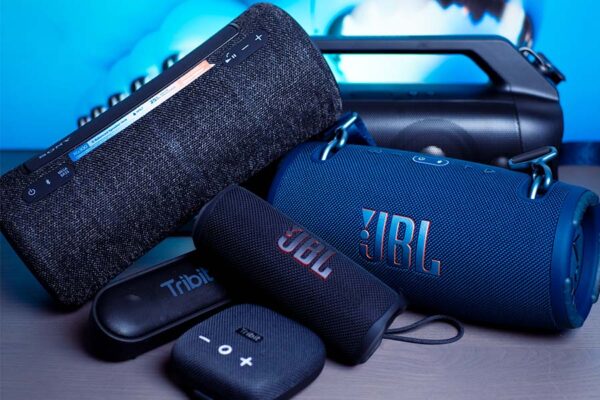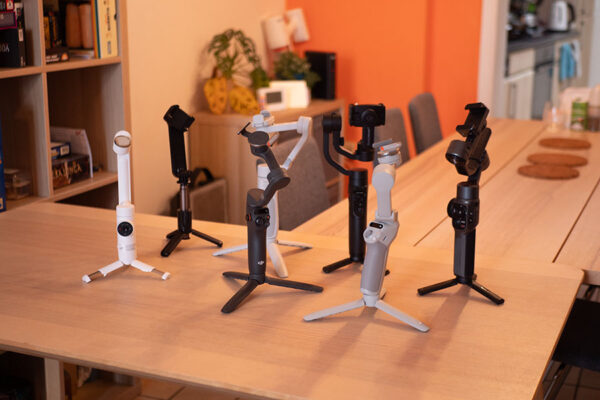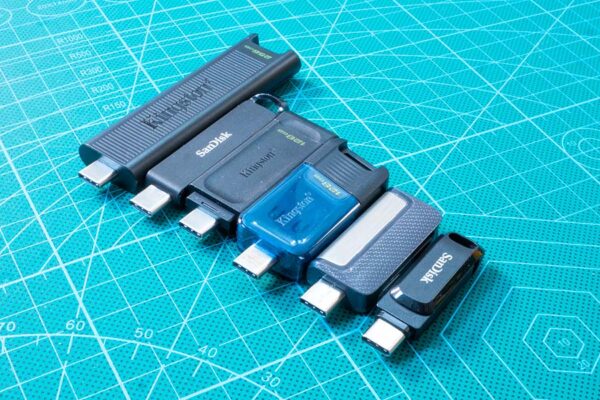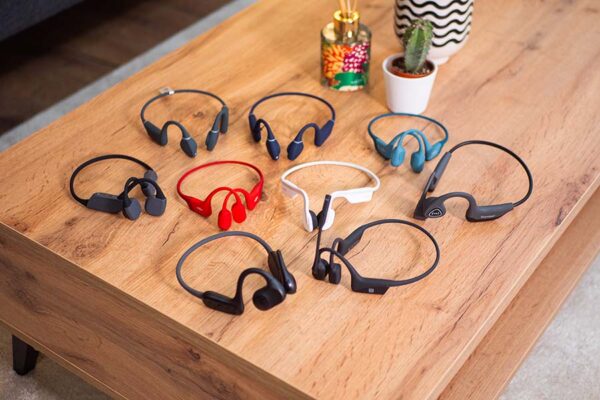Updated on July 20, 2023
Samsung PRO Endurance (128 GB)
The Samsung PRO Endurance, as its name suggests, actually comes into its own in its average writing speed. It’s aimed at people who want to film continuously.

At first glance, this model lags behind the competition. Its read speed can only climb to 100 MB/s, according to the brand, and its write speed to 40 MB/s. The Samsung PRO Endurance, as its name suggests, stands out for its average writing speed. According to the manufacturer, it can withstand up to 5 years of continuous recording (43,800 hours). It is therefore ideal for those who own a dashcam, a hybrid camera for filming or an action cam. During our tests, we managed to achieve values of 35 MB/s write and 120 MB/s read with an old Chromebook (2018), while with a MacBook Air M1, values reached 55 MB/s write and 75 MB/s read using, this time, the SD adapter supplied.
Amazon Basics LSMICRO128GU3 (128 GB)
This very inexpensive model still has some nice technical features, with its U3 and V30 classes in particular guaranteeing minimum speeds of 30 MB/s.
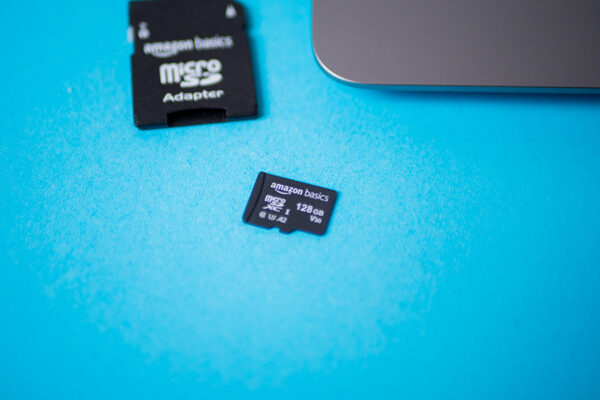
This micro SDXC card is full of pleasant surprises. In fact, as explained above, it not only boasts good ratings, but also very good resistance to shocks, temperatures (from -10°C to 80°C) and IPX6 certification protecting it from water splashes coming from all directions. On top of that, it’s A2-standard, which makes it better than the other inexpensive models we’ve tested. As for speeds, the theoretical 100 MB/s read speed rises to 150 MB/s in test (2018 Chromebook), and the write speed drops to 38 MB/s for its theoretical 60 MB/s (which is still within the norm). With the SD adapter and via a MacBook Air M1, writing speeds increase significantly to 67 MB/s (but drop to 75 MB/s for reading). Available in sizes from 64 GB to 1 TB. Little bonuses: the box includes an SD adapter and a storage case.
Lexar LMSESXX128G-BNAEU (128 GB)
This micro SD card offers equally good writing and reading speeds with its SD adapter. However, it reads faster when used directly, without an adapter.

The Lexar brand tests its products in laboratories and this card has been validated on over 1100 digital devices. As a result, we know that you can store this card between -25 and 85°C and that you can use it in temperatures between 0 and 70°C. Its theoretical read speed is advertised at 100 MB/s, but we’ve seen it go up to 120 MB/s (on a 2018 Chromebook) or down to 75 MB/s when using its SD adapter (on a 2020 MacBook Air M1). On the other hand, it was with its adapter on the MacBook Air that it had the best writing speed (75 MB/s versus 35 MB/s when writing directly to the micro SD card). Finally, note that while its 10, U3 and V30 classes can capture 4K video, its A1 application performance makes it less interesting for smartphone use.
SanDisk Extreme Pro (128 GB)
Offering a higher theoretical reading and A2 application performance, this micro SD card is aimed more at smartphones or for filming in 4K UHD.
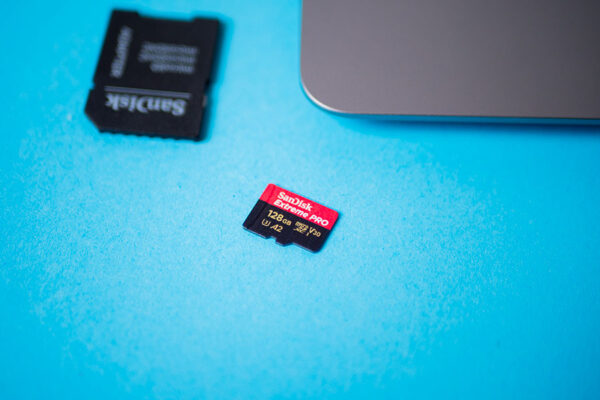
As its name suggests, this micro SD card withstands chaotic environments such as extreme temperatures, water, shock and X-rays. It’s available in sizes from 32GB to 1TB to suit everyone’s needs. With its U3 and V30 classes, it is even interesting for professionals who take photos in sequential burst mode. On the other hand, while the advertised theoretical reading speed is 200 MB/s, we’ve seen that it’s actually lower. In fact, in our tests, it reached a speed of 120 MB/s in direct reading use (without adapter) with a Chromebook (from 2018) and only 75 MB/s with its SD adapter on a MacBook Air (M1 from 2020). On the write side, performance was better using the adapter (67 MB/s vs. 38 MB/s without).
Our selection
Our pick, Best mid-range Best cheap Cheap alternative Mid-range alternative 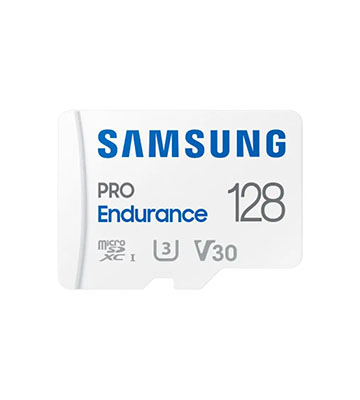
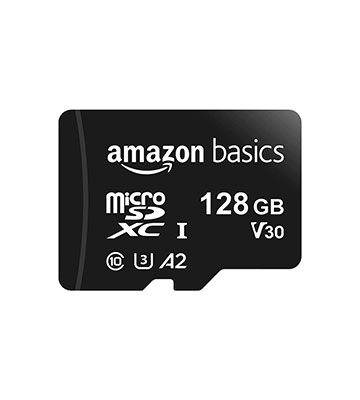

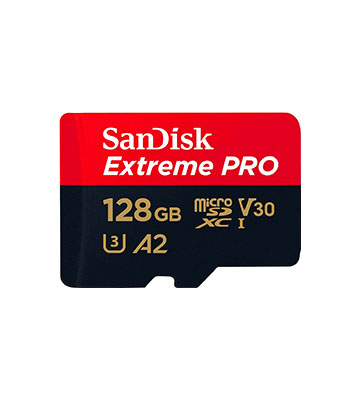
Samsung PRO Endurance (128 GB) Amazon Basics LSMICRO128GU3 (128 GB) Lexar LMSESXX128G-BNAEU (128 GB) SanDisk Extreme Pro (128 GB) The Samsung PRO Endurance, as its name suggests, actually comes into its own in its average writing speed. It's aimed at people who want to film continuously. This very inexpensive model still has some nice technical features, with its U3 and V30 classes in particular guaranteeing minimum speeds of 30 MB/s. This micro SD card offers equally good writing and reading speeds with its SD adapter. However, it reads faster when used directly, without an adapter. Offering a higher theoretical reading and A2 application performance, this micro SD card is aimed more at smartphones or for filming in 4K UHD. £ 23.49 on Amazon £ 9.99 on Amazon See the price on Amazon £ 16.47 on Amazon
Selectos compares and tests hundreds of products to help you buy better. We sometimes receive a commission when you buy through our links, which helps fund our work. Learn moreWhy trust us ?
How did we test?
In order to test the micro SD cards, we started by checking whether they came with accessories such as an SD adapter and/or carrying case. Next, we noted whether the manufacturer indicated their class, bus and application performance, as this is interesting data if you’re looking for the most advanced models.
Then we moved on to the performance tests proper. We timed how long it took each card to transfer the same data (around 600 MB) in read and write mode. Since most people don’t necessarily have a latest-generation laptop at home, we took it upon ourselves to test this with an older and a relatively newer computer: a 2018 Acer Chromebook CB713 and a 2020 MacBook Air M1 with the supplied SD adapter.
How to choose your micro SD card?
The search for a micro SD card can quickly prove complicated. Aside from the speeds advertised by manufacturers, there are more and more symbols on these devices. Some of these markings may even contradict each other.
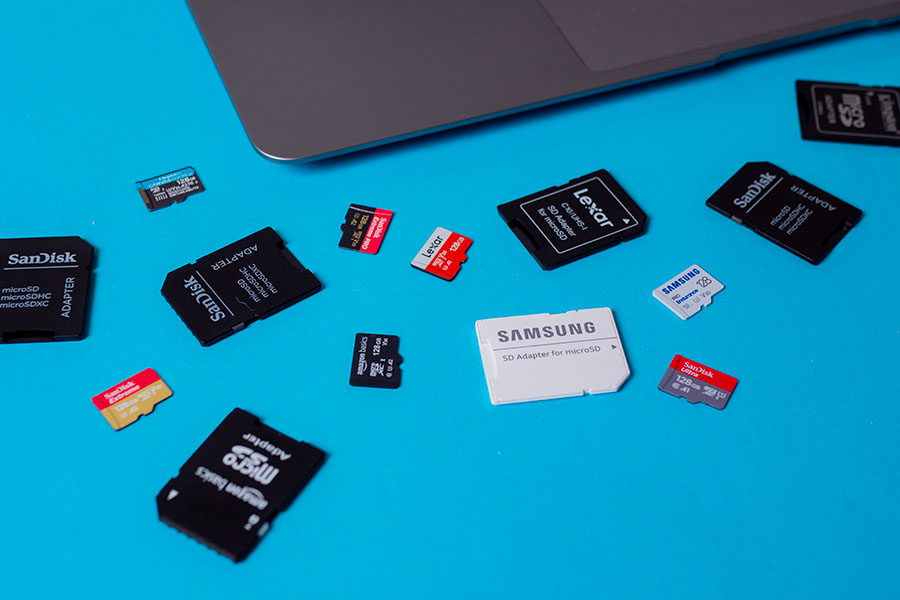
In the same vein, very high data rates should be taken with a grain of salt: to achieve them, you often need write peripherals (a camera, a smartphone or similar) and reading (an SD card reader) devices.
To determine which model is best for you, you can base your decision on the following criteria:
- The type of card:all the models in our comparison are microSDXC cards. This is one of the latest standards, with a maximum capacity of 2 TB. Some relatively old devices are not compatible with this standard: refer to your device’s manual if it’s not recent.
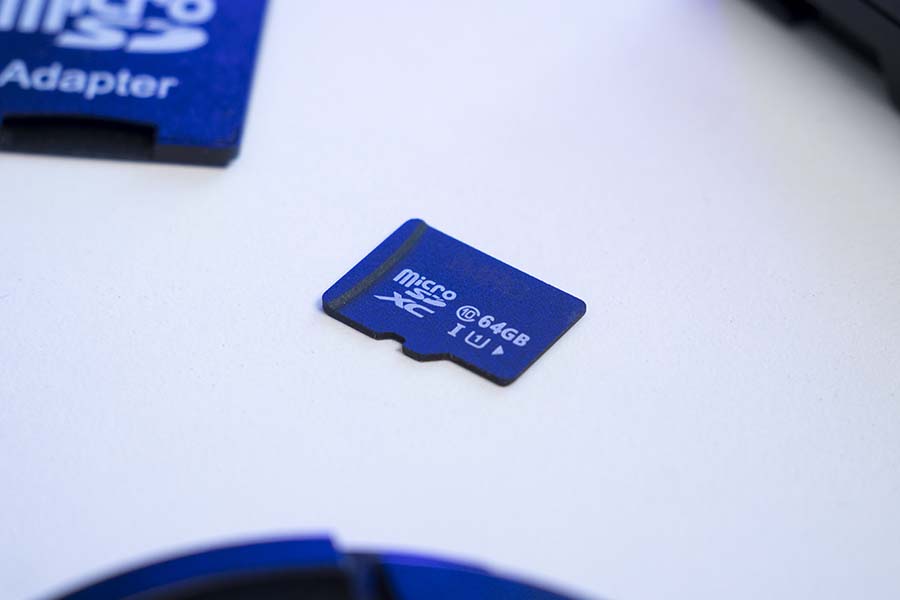
- Read and write speeds:manufacturers generally advertise maximum read and write speeds for their cards. These vary from model to model, and are not always linked to their price range. These are peak speeds, not constant speeds.
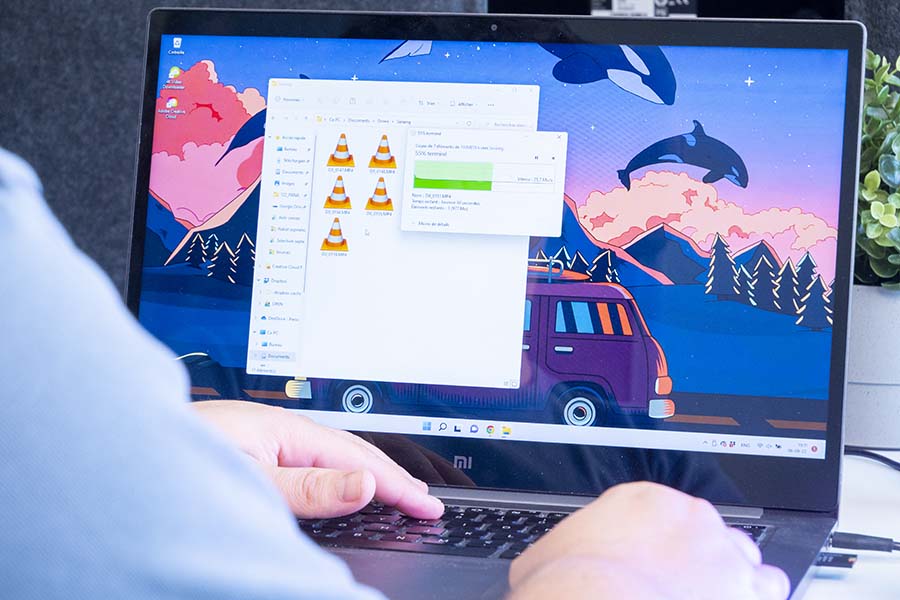
- The class: represented by a U or, more recently, a V, it represents the minimum speed offered by the micro SD card. Classes U1 and U3 indicate a minimum speed of 10 MB/s and 30 MB/s respectively. More intuitively, the V30 and V90 classes mean 30 Mb/s and 90 Mb/s respectively. The V30 class is sufficient to record 4K, while the V60 class already allows 8K recording.
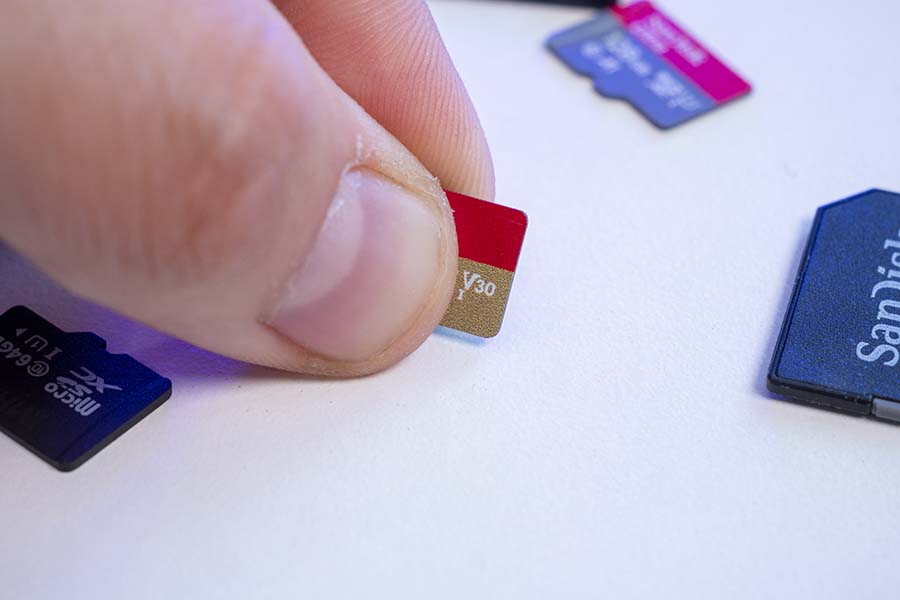
- The bus: the majority of micro SD cards use the UHS-I bus (for Ultra High Speed). This means that the device runs at around 50 MB/s for writing and 100 MB/s for reading. The UHS-II bus, meanwhile, offers speeds three times higher, but compatible hardware is required to take advantage of this speed.
- Application performance:some micro SD cards are particularly well suited to smartphone use. They have A1 and A2 certifications and offer average speeds of 1500 IOPS read and 500 IOPS write respectively, and 4000/2000 IOPS (Input/Output operations Per Second, or input-output operations per second).
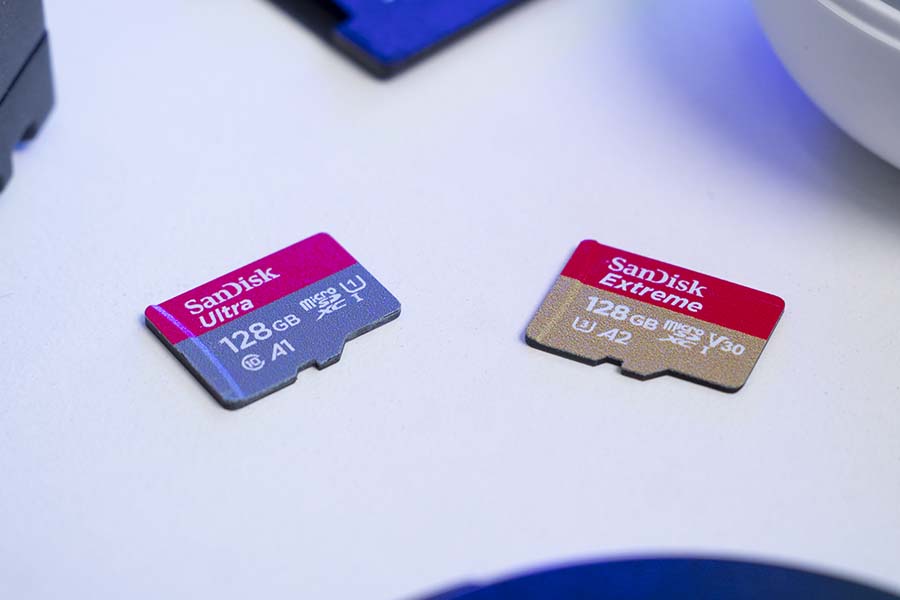
- The little extras : we’re talking here about the design of micro SD cards, and whether they come with accessories such as an SD adapter or even file recovery software.
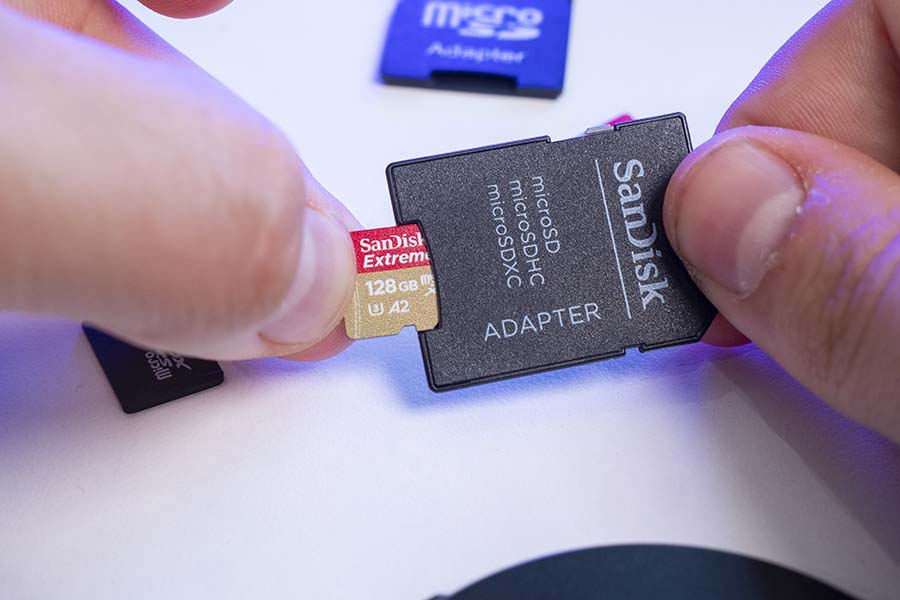
We’re targeting 128 GB micro SD cards here. Many models are available with different storage sizes, but bear in mind that micro SD cards with the same name and smaller capacity may offer lesser performance.
Other micro SD cards we recommend
Kingston Canvas Go! Plus SDCG3 128 GB (€18.27 at time of publication) : A solution that can be stored from -40°C to 85°C. Capable of recording in 4K UHD, this micro SD card includes an SD adapter. It supports classes U3, V30 and A2 in terms of application performance, making it interesting for all kinds of devices (smartphone, tablet, dashcam, drone…). While its theoretical reading speed should normally reach 170 MB/s, it has instead reached 86 MB/s (with adapter on a 2020 MacBook Air) to 100 MB/s (without adapter on a 2018 Chromebook). In writing, it was with the adapter that it achieved better scores during our tests (67 MB/s vs. 40 MB/s with SD adapter).
SanDisk Ultra 128 GB (€18.40 at time of publication): A solution for filming in Full HD. If you don’t need to shoot in 4K UHD, the SanDisk Ultra is for you. In fact, this entry-level solution is suitable for the majority of uses (Nintendo Switch, smartphone, etc.) thanks to its decent performance and the many capacities available. Its application performance meets A1 certification, and it belongs to class U1. As you can see, it’s a far cry from the best models of its kind, even if it’s perfectly usable for the majority of devices on the market (game consoles, smartphones, etc.). In our tests, its read speed reached 120 MB/s on a Chromebook and 75 MB/s with its SD adapter on a MacBook Air. As for writing, we once again had better results with the SD adapter, but they were quite far from the usual standards (32 Mb/s vs. 23 Mb/s without adapter).
SanDisk Extreme 128 GB (€26.49 at time of publication): An alternative to the SanDisk Extreme Pro. During our tests, we noticed that this micro SD card performed slightly less well than its big sister in the main selection. In fact, while it offered exactly the same results with the SD adapter (on a 2020 MacBook Air M1), we found that it was slower in use without the adapter on a 2018 Chromebook compared to the Pro, both in writing and reading. We went from 120 to 100 MB/s reading and from 38 to 27 MB/s writing. However, it’s still a good option if you’re looking for a micro SD card that can be used in extreme circumstances, since it’s resistant to shock, water, X-rays and extreme temperatures.




